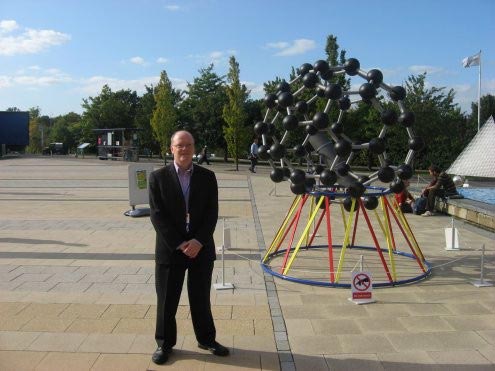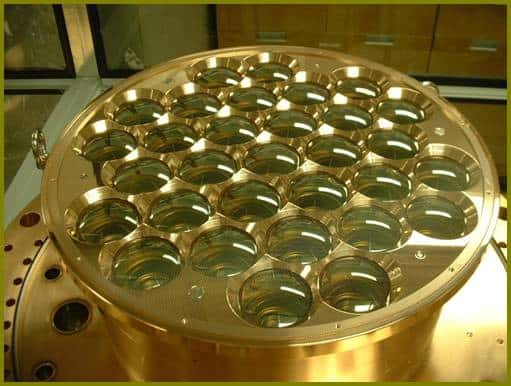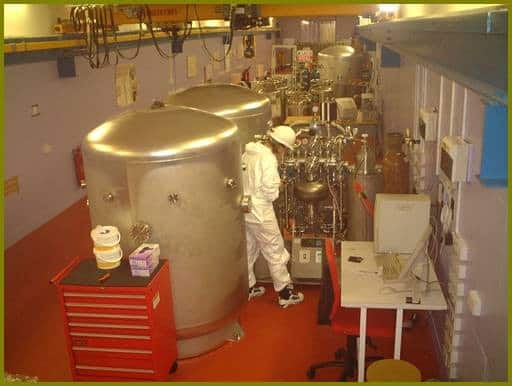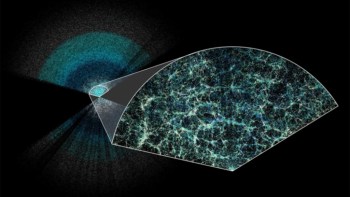Lurking quietly in the bowels of Europe’s second deepest mine, ZEPLIN III will come alive this month as it resumes its search for that mysterious substance they call dark matter. James Dacey catches up with Alex Murphy, leader of the University of Edinburgh’s contribution to the project. Murphy believes that important upgrades to the machine have created the first genuine opportunity for detecting dark matter.
What is dark matter and why does physics need it?
Start with an easy one eh? OK, so first of all, if we look up at the stars and galaxies, and try to apply the laws of gravity that we know work well at the small scales of planet Earth, and even the solar system, they fail. For the laws of gravity to work when looking at things of the size of galaxies or larger, there needs to be much more matter “out there” than we can see. Because it must be quite heavy, and we can’t see it, we call it dark matter.
There’s a pretty good chance that we could discover dark matter in the next few months!
But is there any actual evidence that it exists?
Well there are many different types of measurement that all suggest exactly the same thing. For example, the speeds with which stars rotate about galaxies, or the way that the light that we see from very distant stars is distorted by this “something” in between.
So what do you think this dark matter is — what form would it take?
The answer looks like it comes from particle physics, and a general consensus is building that the answer lies in a framework called “supersymmetry”. This theory suggests that for every particle type we know about, there should be a heavier version – hence the name, supersymmetry. These particles would have been created in much the same way as normal matter at the time of the big bang, and the lightest ones should still be floating around today – this is what we call dark matter.
Why can’t we see it?
It’s because it doesn’t interact at all with light, and only very rarely interacts with anything else. This is the reason why the favoured candidate for dark matter is called “weakly interacting massive particles”, or WIMPs.
So ZEPLIN is looking for WIMPs?
Yes. The astronomy suggests that our galaxy is sitting in the middle of a region of dark matter. This isn’t unusual – since there’s roughly ten times as much mass in dark matter as there is in normal matter, the dark matter distribution is in fact what has determined where the galaxies have formed. The dark matter particles interact so weakly with anything that they can pass right through the Earth, but because there’s so many of them, a very sensitive detector in a place where nothing else can reach it, should be able to see a few of them.
And what does your machine do exactly – how does it work?
It’s really just a bucket of liquid with some very sensitive light detectors in it. But the liquid is xenon, which is one of the noble gas elements, like helium or argon. This has the nice property that if a particle passing through it scatters, as we expect WIMPs to do occasionally, it creates a small flash of light.
We’d also expect some of the xenon atoms to be broken up by such events, separating the xenon atom from some of its electrons. We put almost 20,000 volts across the liquid, which allows us to sweep up these released electrons, which we then use to generate a second flash of light in a layer of gaseous xenon. The combination of the first flash of light and the signal from the electrons tells us that there’s been an event in the detector.
We have focussed on keeping everything as clean and pure and getting the clarity of signal as high as possible
Why is ZEPLIN located deep underground in a salt mine?
Ahh, that’s because of cosmic rays. Inevitably, a detector that’s very sensitive to WIMPs is also very sensitive to many other things. Sitting here in a café we’re being bombarded all the time by cosmic rays coming from space. These are coming from the sun, from supernovae, and even a few from the cores of very distant galaxies. They cause things like the aurora, but for us they’re a pain. Cosmic rays are fast moving particles like electrons and muons, and these can go through quite a bit of material so it’s hard to shield against them. But going deep underground, in a mine, we’re able to get rid of about 99.9999% of them. That’s few enough so as not to be a problem.
But can you really be sure that you are seeing dark matter, not some other source of background noise?
Even down in the mine, there’s still natural radiation coming from the rock itself, from the detector components, from people, in fact everything has some level of radioactivity. We’ve placed ZEPLIN within a cocoon of very low radioactivity plastic and lead, and the device itself is made of very clean materials, but still there’s a few things flying around. Mostly these are gamma rays.
How does the upgrade make ZEPLIN better than other detectors in the world?
We have focussed on keeping everything as clean and pure and getting the clarity of signal as high as possible. I think we’re doing pretty well at that. We are now using newer photomultiplier tubes, those are the light collection devices, and these have much lower levels of intrinsic radiation than the ones we used before.
Also, we’ve built a completely new additional detector around the outside of ZEPLIN. The idea is that if we see an event that interacts in both this new detector, and in ZELPIN, then it can’t be a WIMP. WIMPs interact so rarely that there’s no chance whatsoever of them scattering in both detectors. Background neutrons could, so it’s an extra measure to be sure of what we are seeing.
So you’re looking forward to this latest run — what’s the timetable?
There’s a pretty good chance that we could discover dark matter in the next few months! There is nothing more exciting and more timely in UK physics at the moment…
We finished calibrating the detector in September and we hope to start running for dark matter data starting in December or even as early as November. The plan is to run it for a year without looking at data until end of the experiment. We do this “blind” so as to minimize the extent to which we could influence the experiment. History tells us that it’s very easy to unwittingly alter things so as to get the result you want and this is a standard technique to avoid that.
How do you handle the competitive element of the dark matter search – is there much international collaboration or is it all very secretive?
A lot of them are good friends, it’s just a rivalry…I mean…it’s a big prize…right?
Well, I guess it works as well as one could expect. I mean there are currently three groups in the world that are leading in terms of limits – there’s the Cryogenic Dark Matter Search in the US, there’s the Xenon100 team based in Italy, and then there’s us, and we all have similar limits at the moment. We don’t talk that much to each other because it’s all quite secret. All the time we’re thinking of clever ideas to tune the instruments and usually these are closely guarded secrets.
So there is a strong sense of rivalry?
Well, we’re not going to go around putting plutonium jabs into people to bump off the enemy players! A lot of them are good friends, it’s just a rivalry…I mean…it’s a big prize…right? But I think in general the rivalry and the difficulty of getting funding means that the science advances quicker than it would do otherwise.
Do you feel there are any areas of the science that could benefit from a more open approach?
We could definitely improve the way in which data is shared. Every group tends to present their results via a different style and this makes it more difficult than one would hope to compare results.
Can you tell me a little bit about your particular role?
I’m head of the Edinburgh contribution to the ZEPLIN III project. This means that probably 95 percent of the time behind a computer – updating spreadsheets, applying for money etc – that’s the bit I like the least… it’s always a last minute rush.
And which bits do you enjoy the most?
Well, it’s got to be the diversity – the way I do something different every day. The best bits of time are with PhD students guiding them with their projects. And, I do a fair bit of public understanding of science events. I’ve done a café scientifique in Moscow [informal science talks in café and bars], which was pretty scary, and run a few schools events, hopefully enthusing younger kids into science, showing them its not some kind of incredible magic, but that they can understand it and make a contribution. I also run a lot of talks back in Edinburgh.
Do you think the public can understand topics as difficult as dark energy?
Given the opportunity I think they can. The biggest problem is not in the conveying of ideas, it’s constraining the imagination of people listening not to go further. You can show them one little bit and they’re bright enough to start thinking about how the whole thing may fit together – but trying to answer some of those questions – that’s not an hour’s talk – that’s a lifetime’s talk!
ZEPLIN-III is a joint project of the University of Edinburgh, Imperial College London, the Rutherford Appleton Laboratory, and international partners in Portugal and Russia. To learn more about the project please visit the ZEPLIN III homepage.







